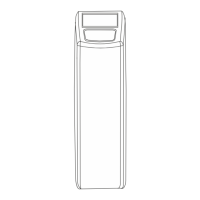1. mains water supply (untreated water).
2. inlet of appliance (untreated water).
3. outlet of appliance (treated water).
4. house/application (treated water).
STEP 1. Install the 3-valve bypass system.
STEP 2. Screw the connection kit with nuts onto the elbow
connections of the appliance (2 & 3); make sure to install
the gasket seals. Tighten the nuts firmly by hand.
STEP 3. Connect the 3-valve bypass system to the adaptors
on the in (2) and out (3) elbow connections.
STEP 4. Connect the mains water supply to the inlet
of the 3-valve bypass system (1).
STEP 5. Connect the house/application to the outlet
of the 3-valve bypass system (4).
WITH 3-VALVE BYPASS SYSTEM
(not included).
- We recommend the use of a stand pipe with air trap.
- To prevent backflow from the drainage system into
the appliance, always make sure to have an air gap
between the end of the drain line and the drainage
system itself; as a rule of thumb, the air gap should
be minimum 2x the diameter of the drain line.
- Always use separate drain hoses for the control valve
(evacuation of rinse water) and the cabinet's overflow.
- Lay-out the drain hoses in such a way that pressure
loss is minimized; avoid kinks and unnecessary
elevations.
- Make sure that the sewerage system is suitable
for the rinse water flow rate of the appliance.
DRAIN
2
3
1
7
INSTALLATION
1
4
STEP 1. Connect a 13 mm hose to the drain solenoid of the
control valve (1); secure it by means of a clamp.
STEP 2. Run the drain hose to the drainage system and
connect it to the stand pipe assuring sufficient air gap. This
drain line operates under pressure, so it may be installed
higher than the appliance.
STEP 3. Connect a 13 mm hose to the cabinet overflow
elbow, located at the back side of the appliance; secure it
by means of a clamp.
STEP 4. Run the drain hose to the drainage system and
connect it to the stand pipe assuring sufficient air gap. This
drain line does NOT operate under pressure, so it may NOT
be installed higher than the appliance.

